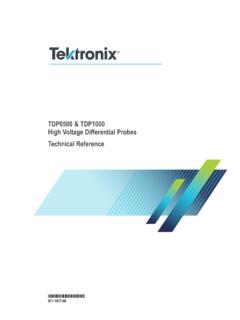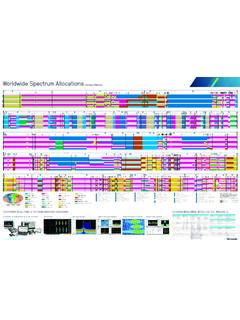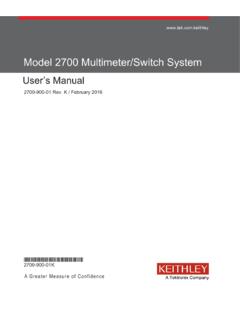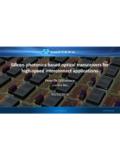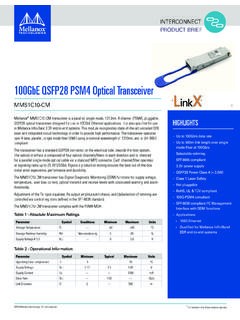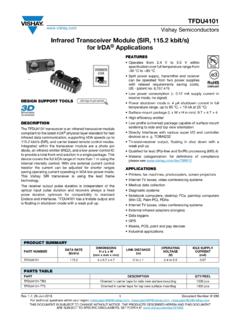Transcription of Analyzing 26-53 GBaud PAM4 Optical and Electrical Signals
1 Analyzing 26-53 GBaud PAM4. Optical and Electrical Signals . APPLICATION NOTE. Analyzing 26-53 GBaud PAM4 Optical and Electrical Signals APPLICATION NOTE. Contents 1. 3 4. Analyzing PAM4 PAM4 versions of OMA and 2. Current PAM4 4. TDECQ Transmitter and Dispersion Eye 3. Debugging PAM4 Systems and 7 Closure Test setup and Transition The role of reference receivers in debug EH and EW Eye Height and Eye testing and compliance SNDR Signal to Noise and Distortion Error Level Separation Mismatch Ratio Test ESMW Eye Symmetry Mask 5. Critical Test Equipment 2 | Analyzing 26-53 GBaud PAM4 Optical and Electrical Signals APPLICATION NOTE. 1. Introduction This paper presents techniques for Analyzing 50+ Gb/s Optical and Electrical PAM4 Signals .
2 Drawing primarily from the PAM4 (4-level pulse amplitude modulation) is being adopted latest emerging technologies, 50/100/200/400 GbE (gigabit in many applications at data rates of 50 Gb/s and higher. By Ethernet, IEEE and ) and OIF-CEI ( Optical encoding two bits in each symbol, PAM4 Signals use half the Internetworking Forum-Common Electrical Interface), we'll look bandwidth of the logic-emulating NRZ (non-return to zero). at signal analysis from the perspectives of compliance and modulation scheme to transmit at the same data rate. debug testing for both components and systems. Operating at half the bandwidth sidesteps the crippling effects In the next section we give a brief summary of PAM4 standards of loss and inter-symbol interference caused by nonuniform and their topologies.
3 Section 3 discusses test configurations channel frequency response, but the advantages of PAM4. for debugging Optical and Electrical Signals . In Section 4, we come at a cost: the complexities of a four level system, 12. work through the key PAM4 Optical and Electrical compliance different symbol transitions, each with its own slew rate, and a tests and conclude in Section 5 with a summary of the test drop in SNR (signal to noise ratio) of at least a factor of three, equipment features and requirements that you need to debug dB for Electrical voltage and dB for Optical power. PAM4 transceivers and perform standards compliance tests. The dramatic SNR drop is addressed in most cases by the introduction of forward error correction.
4 FEC provides the performance margin necessary to raise the maximum permitted raw BER (bit error ratio) from 1E-12 to At such high BERs, real time oscilloscopes are capable of measuring BER without approximation or extrapolation . terrain that used to be reserved for expensive and inflexible BERTs (BER testers). | 3. Analyzing 26-53 GBaud PAM4 Optical and Electrical Signals APPLICATION NOTE. FIGURE 1. PAM4 waveform (top) and eye diagram (bottom). 2. Current PAM4 Technologies Since each PAM4 symbol carries two bits, one symbol error can result in either one or two bit errors. Gray coding helps Figure 1 shows a PAM4 waveform and eye diagram. The four SER (symbol error ratio) converge to BER by encoding the bit PAM4 symbols are the power or voltage levels of the signal.
5 Pairs 11 in S2 and 10 in S3, but we shouldn't assume that SER. The symbols are usually referred to from lowest level to and BER are equal. highest as S0, S1, S2, S3 and for Electrical Signals can also be described as -1, -1/3, 1/3, 1, the latter indicates the desired even spacing of the four amplitude levels. The three eye diagrams are called low, middle, and upper. 4 | Analyzing 26-53 GBaud PAM4 Optical and Electrical Signals APPLICATION NOTE. FIGURE 2. (a) A single lane, MM fiber configuration ( , 50 GBASE-SR), (b) a multi-lane configuration with one wavelength per MM or SM fiber ( , 100 GBASE-SR2. MM or 400 GBASE-DR4 SM), and (c) a multi-lane WDM configuration, with all wavelengths multiplexed onto one SM fiber ( , 400 GBASE-LR8).
6 PAM4 signaling is being deployed in both single and multi- to modal dispersion. To achieve higher data rates, several channel systems. A single 26 GBd PAM4 signal can be Optical PAM4 Signals can be transmitted, each on its own SM. transmitted on either a SM (single mode) or MM (multi mode) or MM fiber, Figure 2b. Alternatively, WDM (wavelength division fiber, Figure 2a. MM (multi-mode) fibers are limited to one multiplexed) systems combine separate Optical PAM4 Signals , wavelength each and have limited reach of about 100 m due each with its own wavelength, onto a single SM fiber, Figure 2c. | 5. Analyzing 26-53 GBaud PAM4 Optical and Electrical Signals APPLICATION NOTE. The properties of the PAM4 IEEE and (GbE), For Electrical signaling, the OIF-CEI ( Optical Internetworking- OIF-CEI , and 64 GFC configurations are summarized Common Electrical Interface) requirements of pre-FEC BER.
7 In Table 1. These Optical and Electrical standards cover 1E-6 for VSR (very short reach) and MR (medium reach) Signals applications for Optical signal transmission across fibers and and 1E-4 for LR (long reach) Signals are designed to assure Electrical chip-to-chip, chip-to- Optical module, and module-to- post-FEC BER 1E-15. Since FEC cannot correct long burst chip transmission across PCB (printed circuit board) including errors, OIF-CEI limits the maximum allowed burst error lengths the necessary connectors. per 1E20 symbols: for VSR the maximum burst error length is 15 PAM4 symbols, for MR it's 94 symbols, and for LR it's 126. Notice the BER requirements in the right hand column. The symbols.
8 Pre-FEC BER requirement, BER for Optical signaling should assure that the corrected, post-FEC BER is less than 1E-13. FLR (frame loss ratio) is the ratio of validated 64 octet frames to the total number of frames received; FLR is a post- FEC requirement. STANDARD Optical Electrical REACH RATE PRE-FEC BER / POST-FEC FLR. 50 GbE 50 GBASE-SR 1 MM GBd BER 10-4. 100 GbE 100 GBASE-SR2 2 MM 100 m 2 GBd FLR 10-13. 200 GBASE-SR4 4 MM. 200 GbE 200 GBASE-DR4 4 WDM SM 500 m 4 GBd 200 GAUI-4 4 Traces PCB ~250 mm BER 10-4. 400 GBASE-FR8 8 WDM SM 2 km 8 GBd FLR 10-12. 400 GBASE-LR8 8 WDM SM 10 km 8 GBd 400 GbE. 400 GBASE-DR4 4 SM 500 m 4 GBd 400 GAUI-8 8 Traces PCB ~250 mm 8 GBd CEI-56G-VSR ~150 mm BER 10-6.
9 OIF-CEI CEI-56G-MR 1 Trace PCB ~500 mm 18-29 GBd CEI-56G-LR ~1 m BER 10-4. 4 MM ~150 mm Fibre Channel 64 GFC 4 SM 2 km GBd TBD. 4 Traces PCB ~150 mm TABLE 1. Properties of some PAM4 50, 100, 200 and 400 GbE, OIF-CEI 56G, and 64 GFC configurations. 6 | Analyzing 26-53 GBaud PAM4 Optical and Electrical Signals APPLICATION NOTE. FIGURE 3. Typical (a) Optical and (b) Electrical transmitter test set ups. 3. Debugging PAM4 Systems and TEST SETUP AND CONCEPTS. Transceivers Figure 3 shows typical setups for transmitter testing . In Figure 3a an Optical signal is transmitted through a fiber that testing a transceiver for compliance to the specified generates CD (chromatic dispersion) and is then analyzed requirements of a technology standard should assure that by an oscilloscope equipped with a precision O/E ( Optical to any signal that it transmits will be interoperable with any Electrical ) converter.
10 The resulting voltage waveform must be combination of other compliant channels and transceivers. an accurate image of the Optical power waveform. Diagnostic or debug testing , on the other hand, uncovers the flaws that cause transceivers to malfunction or fail a In Figure 3b, an Electrical signal is transmitted through a compliance test. compliance test board that introduces ISI (inter-symbol interference) and loss to challenge transmitter equalization. A. One key difference between compliance testing and diagnostic test fixture is usually required to deliver the Electrical signal to testing is that compliance tests challenge the signal in a the oscilloscope. If you provide the relevant S-parameters, the representative environment with a stressful test pattern, all oscilloscope can embed the desired effects of the compliance channels turned on to generate maximum crosstalk, and the test board and/or de-embed the undesired effects of the text signal transmitted through a compliance test fiber or channel.

